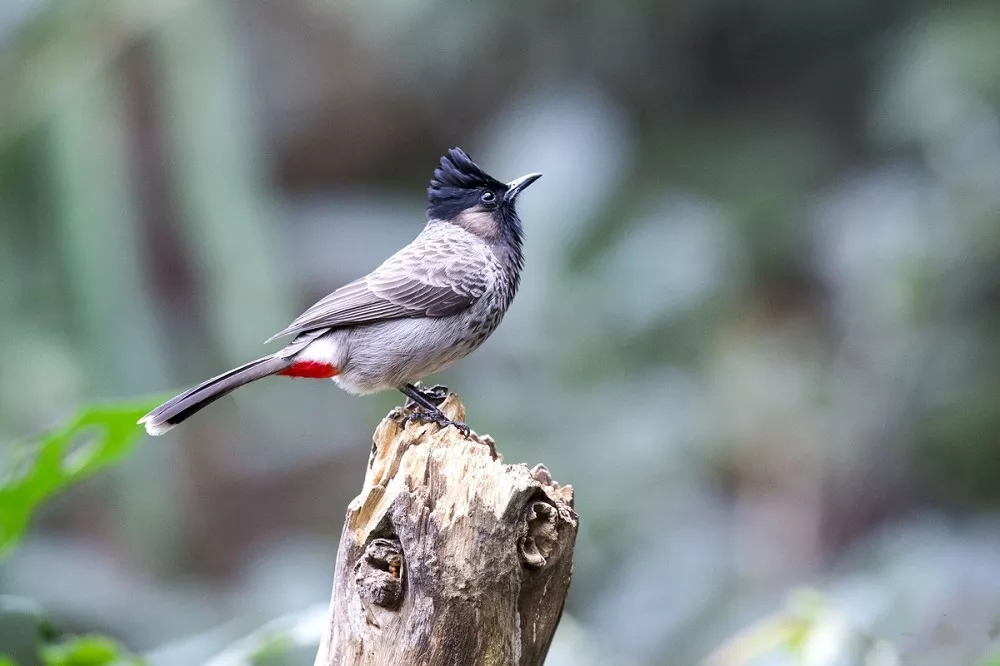The red-vented bulbul (Pycnonotus cafer) is a member of the bulbul family of passerines. It is a medium-sized brown bulbul with a body length of 19-23 cm. The forehead to the top of the head, the eyes, the eyes, the base of the mouth, the chin, and the throat are all black, with a crest, and the ear feathers are reddish brown. Back dark brown to dark brown. The lower tail coverts are crimson, the upper tail coverts are nearly white, the iris is dark brown; the beak is black; the feet are dark horny to black.
What does red-vented bulbul look like
The red-vented bulbul is black and metallic from the forehead to the top of the head, with a short black crest on the top of the head. Neck to back, shoulders dark brown to dark brown, with broad gray feather margins, scales formed on upper body, waist dark brown or taupe. The tail coverts are white or nearly white, and the tail is black with white end spots. The coverts on the wings are the same color as the back, and the flight feathers are dark brown, except for the outer flight feathers, most of them have gray feather edges. The eyes, around the eyes, mouth base, chin, and throat are black, the breast is dark brown to chestnut brown, with off-white feather margins, the belly is white, and the undertail coverts are blood red.
Iris dark brown, bill black, feet black or dark brown.
Red-vented bulbul habitat
It mainly inhabits hills and plains below 1000 meters above sea level, and occasionally goes up to low mountain areas of 1000-1500 meters. It often lives in shrubs, bamboo forests, and forest margins of evergreen broad-leaved forests, and also appears in shrubs in villages and farmland areas. groves, canals, and prop-side trees, and sometimes even into human settlements such as town parks, suburban parks, and vegetable gardens.
Red-vented bulbul living habit
The Red-vented bulbul is a resident bird and does not migrate. They often move in pairs or small groups, and also form loose groups when food is abundant or when foraging. They also live together in groups at night.
What does Red-vented bulbul eat
Feeds mainly on plant fruits, seeds and insects. Omnivorous, mainly insects in summer, and plant food in other seasons. In addition to eating plant fruits and seeds in winter, they also eat some young shoots and leaves. Forages mainly on shrubs or grass, and sometimes flies in the air to prey on insects.
Distribution range of Red-vented bulbul
Origin: Afghanistan, Bangladesh, Bhutan, China, India, Myanmar, Nepal, Pakistan, Sri Lanka, Vietnam.
Mode of reproduction
The breeding season is from April to July. It usually nests in bushes, bamboo forests and small trees, and the height from the ground is usually less than 3 meters. The nest is cup-shaped, mainly composed of dry grass stems, grass roots, grass leaves, etc., and there are often some spider webs outside. Each clutch lays 2-4 eggs. Eggs are pale pinkish white with dark red and lavender spots, and the egg size is 20-24 mm × 15-17 mm. The male and female take turns incubating the eggs, and the incubation period is 14 days. The chicks are late mature, and the male and female parents brood together.
Close species difference
Red-whiskered bulbul and Red-vented bulbul are very similar in appearance, but Red-whiskered bulbul is slightly smaller, with red and white spots in the ear area, white chin and throat; Red-vented bulbul only has black chin and upper throat, and the rest of the lower body White or light gray, with white ear feathers, which can be clearly distinguished from it in the wild.


 Facebook
Facebook  Instagram
Instagram  Youtube
Youtube 